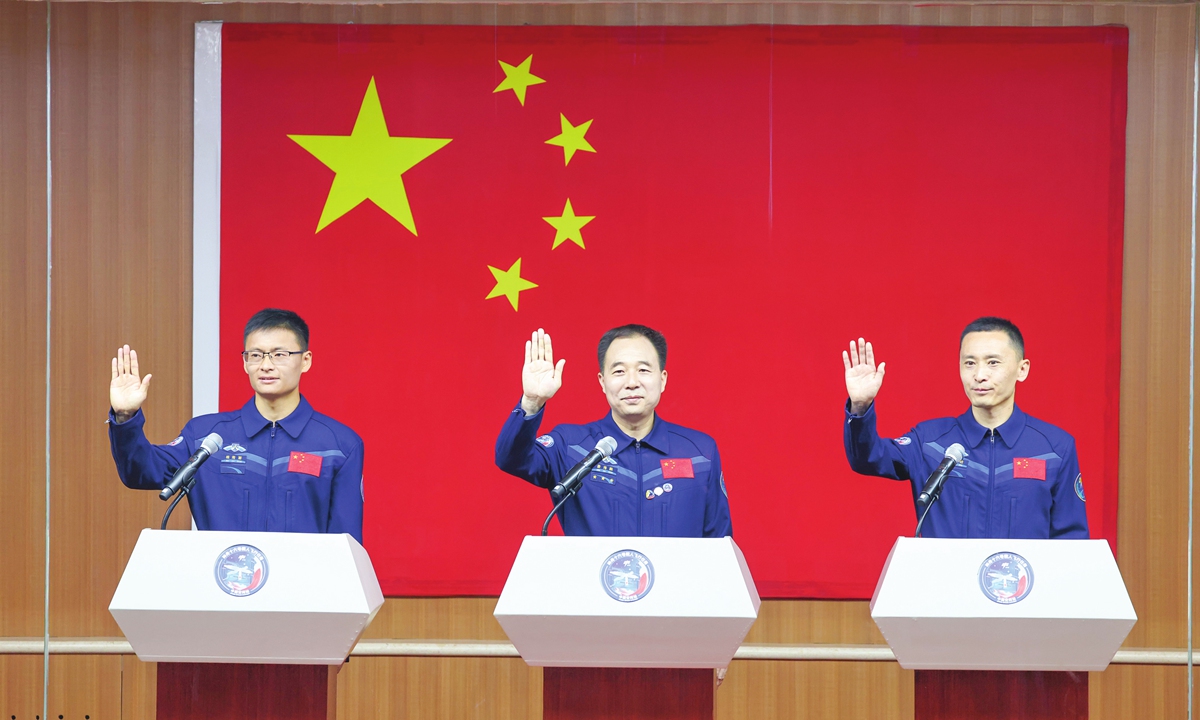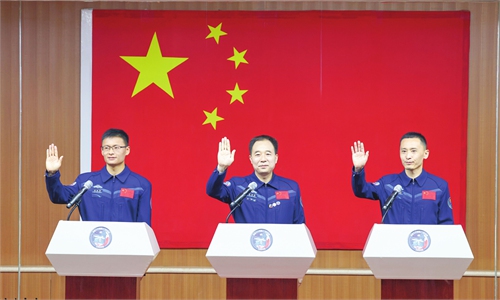China unveils Shenzhou-16 crew for space station mission, launch scheduled on May 30
Payload expert, spaceflight engineer onboard first mission at space station operational phase

The crew of the upcoming Shenzhou-16 manned spaceflight mission, Jing Haipeng (center), Zhu Yangzhu (right) and Gui Haichao, makes its first collective appearance at the Jiuquan Satellite Launch Center in Northwest China's Gansu Province on May 29. Photo: Xinhua
The China Manned Space Agency (CMSA) unveiled the crew of upcoming Shenzhou-16 manned spaceflight mission on Monday. Veteran taikonaut Jing Haipeng, who will visit space for the fourth time during the mission set to be launched on Tuesday at 9:31 am, will serve as the mission commander and lead two fresh faces from the third cohort of Chinese astronauts.
Following the traditional pattern of "one veteran plus two younger members" for the China Space Station crewed missions, Jing, born in 1966, a member of the first batch of taikonauts who has previously participated in Shenzhou-7 manned spaceflight mission in September 2008, served as the mission commander of the Shenzhou-9 mission in June 2012 and Shenzhou-11 in October 2016, will lead the new crew as mission commander and space pilot for the Shenzhou-16 mission.
Zhu Yangzhu, born in 1986, was selected as a candidate of the country's third generation of taikonauts in September 2020, and will serve as the spaceflight engineer for the upcoming mission, which will be his first trip to space.
Gui Haichao, born in 1986, is also a member of the same group of taikonauts, gained most attention during the Monday showcase, not only because of his rare look with a pair of glasses but also of that his university background. Gui is the first-ever Shenzhou taikonaut who is not from the country's astronaut corps and is a college professor from Beihang University, and he will act as the payload expert in his maiden flight mission to space.
As the first manned spaceflight mission at the China Space Station application and development stage, Shenzhou-16 mission will include two dockings and two evacuation returns, according to the CMSA spokesperson Lin Xiqiang on Monday at a press conference in Jiuquan Satellite Launch Center in Northwest China's Gansu Province.
Shenzhou-16 manned spaceflight mission will for the first time consist of all three types of taikonauts - a space pilot, flight engineer and payload expert. It will be the first manned space flight mission for the latter two types of taikonauts, Lin told the media.
It is planned that China will launch the Shenzhou-16 manned spaceflight mission from Jiuquan Satellite Launch Center on Tuesday morning at 9:31 am, the Global Times has learned from the CMSA.
Confident display
According to the CMSA, the Shenzhou-16 crew will stay and work in space for about five months, and they are tasked to conduct space hand-over with the Shenzhou-15 crew, carry out in-orbit experiment of space science and application payload, execute space walks, install payload outside the space station cabin and repair and maintain the space station, among other tasks.
The Global Times found that the trio with the average age of 42.7, marked the youngest line-up for the China Space Station manned spaceflight mission, much younger than Shenzhou-12 at 52, -13 at 45.6 and -14 at 44 and Shenzhou-15 at 53. The new crew members are all members of the Communist Party of China.
"Payload experts and spaceflight engineers are all talents with expertise and especially the payload experts who are not necessarily from a professional pilot background. The lineup showed the expansion of talents pool for China's manned space," Song Zhongping, a space watcher and TV commentator, told the Global Times on Monday.
Song hailed that being able to send astronauts with different backgrounds into space showed the rapid advancement of China's manned spacecraft technology and great confidence, as more ordinary people could stand with the overloading experience during the space trip riding our spacecraft, Song said, noting that "it also marked a great stride we have made in China's push into space."
Many space lovers on Monday commented online that they were especially encouraged and inspired by the appearance of payload expert Gui in the trio, saying that we are worried no more and we could visit the space even with a pair of glasses on.
Judging from the previous records of international space, astronauts with myopia can still go to space wearing a pair of glasses, but they might have to take off the glasses during launch and return stage, Pang Zhihao, a senior space expert, told the Global Times.
As a matter of fact, approximately 80 percent of astronauts wear glasses or contact lenses to correct some sort of vision problems, according to space website LunarSail.com.
According to Wang Zhen, a senior engineer with the CMSA, when selecting astronauts, the medical requirements for payload experts are different from those for other types of astronauts.
Relatively speaking, the vision requirements for payload experts are lower, so it is no problem to wear glasses. During liftoff, especially during the ascent, astronauts will experience the vibration of the rocket while sitting in the spacecraft. If you wear glasses, it may interfere with the face window of the pressure suit in the cabin, or a collision may occur. Therefore, astronauts will not wear glasses during the ascent phase of the launch mission, Wang explained.
Ready for more
Lin, the CMSA spokesperson, also revealed on Monday that as China Space Station has entered its application and development stage that will be operational for more than a decade, we now possessed the complete transport system for Earth-space commute, as well as mature astronaut training and supply systems. "It is safe to say that we are ready to carry out relevant works to have foreign astronauts to fly with our space station," Lin said.
Currently, we are actively pushing forward preparations and we are looking forward to having foreign astronauts to participate in China Space Station spaceflight missions, Lin noted.
And to further support in-orbit scientific experiment and provide better conditions for astronauts' work and life, China will launch expansion modules to the space station in the due course, so that the structure of the China Space Station will be upgraded into the cross shape from the current T shape. Such transformation will further reduce the space cargo uploading cost and increasing flexibility for the supply mission, according to Lin.
The CMSA spokesperson also outlined the country's plan to send taikonauts to Moon for the first time before 2030, and to explore the Earth's natural satellite and verify relevant technology, as well as to complete the multiple tasks of "landing, roving, sampling, researching and returning" of/from Moon.
According to Lin, the CMSA has initiated comprehensive research and construction works toward such goals including developing the new-generation manned launcher Long March-10, the new-generation manned spacecraft, the lunar surface lander and space suit for Moon landing.
The CMSA on Monday issued a public notice on Monday to solicit ideas for the manned lunar rover, saying that the vehicle will carry two astronauts for their lunar exploration and scientific research missions.
And according to the current mission design, the manned lunar rover will have functions such as manned driving, lunar surface movement, positioning support, and safety assistance, and can provide astronauts with mobility, communication, and detection assistance.


